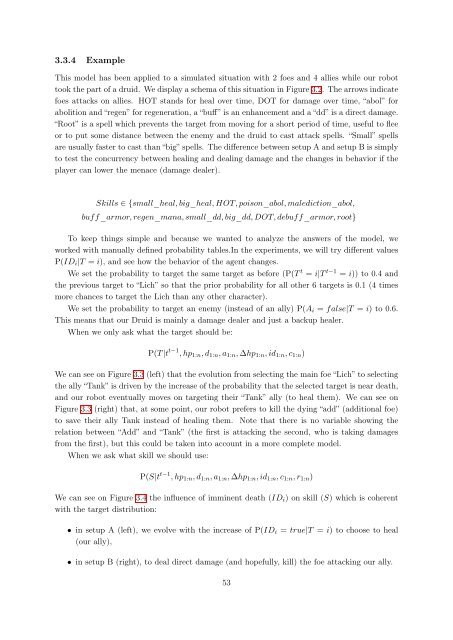Bayesian Programming and Learning for Multi-Player Video Games ...
Bayesian Programming and Learning for Multi-Player Video Games ...
Bayesian Programming and Learning for Multi-Player Video Games ...
Create successful ePaper yourself
Turn your PDF publications into a flip-book with our unique Google optimized e-Paper software.
3.3.4 Example<br />
This model has been applied to a simulated situation with 2 foes <strong>and</strong> 4 allies while our robot<br />
took the part of a druid. We display a schema of this situation in Figure 3.2. The arrows indicate<br />
foes attacks on allies. HOT st<strong>and</strong>s <strong>for</strong> heal over time, DOT <strong>for</strong> damage over time, “abol” <strong>for</strong><br />
abolition <strong>and</strong> “regen” <strong>for</strong> regeneration, a “buff” is an enhancement <strong>and</strong> a “dd” is a direct damage.<br />
“Root” is a spell which prevents the target from moving <strong>for</strong> a short period of time, useful to flee<br />
or to put some distance between the enemy <strong>and</strong> the druid to cast attack spells. “Small” spells<br />
are usually faster to cast than “big” spells. The difference between setup A <strong>and</strong> setup B is simply<br />
to test the concurrency between healing <strong>and</strong> dealing damage <strong>and</strong> the changes in behavior if the<br />
player can lower the menace (damage dealer).<br />
Skills ∈ {small_heal, big_heal, HOT, poison_abol, malediction_abol,<br />
buff_armor, regen_mana, small_dd, big_dd, DOT, debuff_armor, root}<br />
To keep things simple <strong>and</strong> because we wanted to analyze the answers of the model, we<br />
worked with manually defined probability tables.In the experiments, we will try different values<br />
P(IDi|T = i), <strong>and</strong> see how the behavior of the agent changes.<br />
We set the probability to target the same target as be<strong>for</strong>e (P(T t = i|T t−1 = i)) to 0.4 <strong>and</strong><br />
the previous target to “Lich” so that the prior probability <strong>for</strong> all other 6 targets is 0.1 (4 times<br />
more chances to target the Lich than any other character).<br />
We set the probability to target an enemy (instead of an ally) P(Ai = false|T = i) to 0.6.<br />
This means that our Druid is mainly a damage dealer <strong>and</strong> just a backup healer.<br />
When we only ask what the target should be:<br />
P(T |t t−1 , hp1:n, d1:n, a1:n, ∆hp1:n, id1:n, c1:n)<br />
We can see on Figure 3.3 (left) that the evolution from selecting the main foe “Lich” to selecting<br />
the ally “Tank” is driven by the increase of the probability that the selected target is near death,<br />
<strong>and</strong> our robot eventually moves on targeting their “Tank” ally (to heal them). We can see on<br />
Figure 3.3 (right) that, at some point, our robot prefers to kill the dying “add” (additional foe)<br />
to save their ally Tank instead of healing them. Note that there is no variable showing the<br />
relation between “Add” <strong>and</strong> “Tank” (the first is attacking the second, who is taking damages<br />
from the first), but this could be taken into account in a more complete model.<br />
When we ask what skill we should use:<br />
P(S|t t−1 , hp1:n, d1:n, a1:n, ∆hp1:n, id1:n, c1:n, r1:n)<br />
We can see on Figure 3.4 the influence of imminent death (IDi) on skill (S) which is coherent<br />
with the target distribution:<br />
• in setup A (left), we evolve with the increase of P(IDi = true|T = i) to choose to heal<br />
(our ally),<br />
• in setup B (right), to deal direct damage (<strong>and</strong> hopefully, kill) the foe attacking our ally.<br />
53


